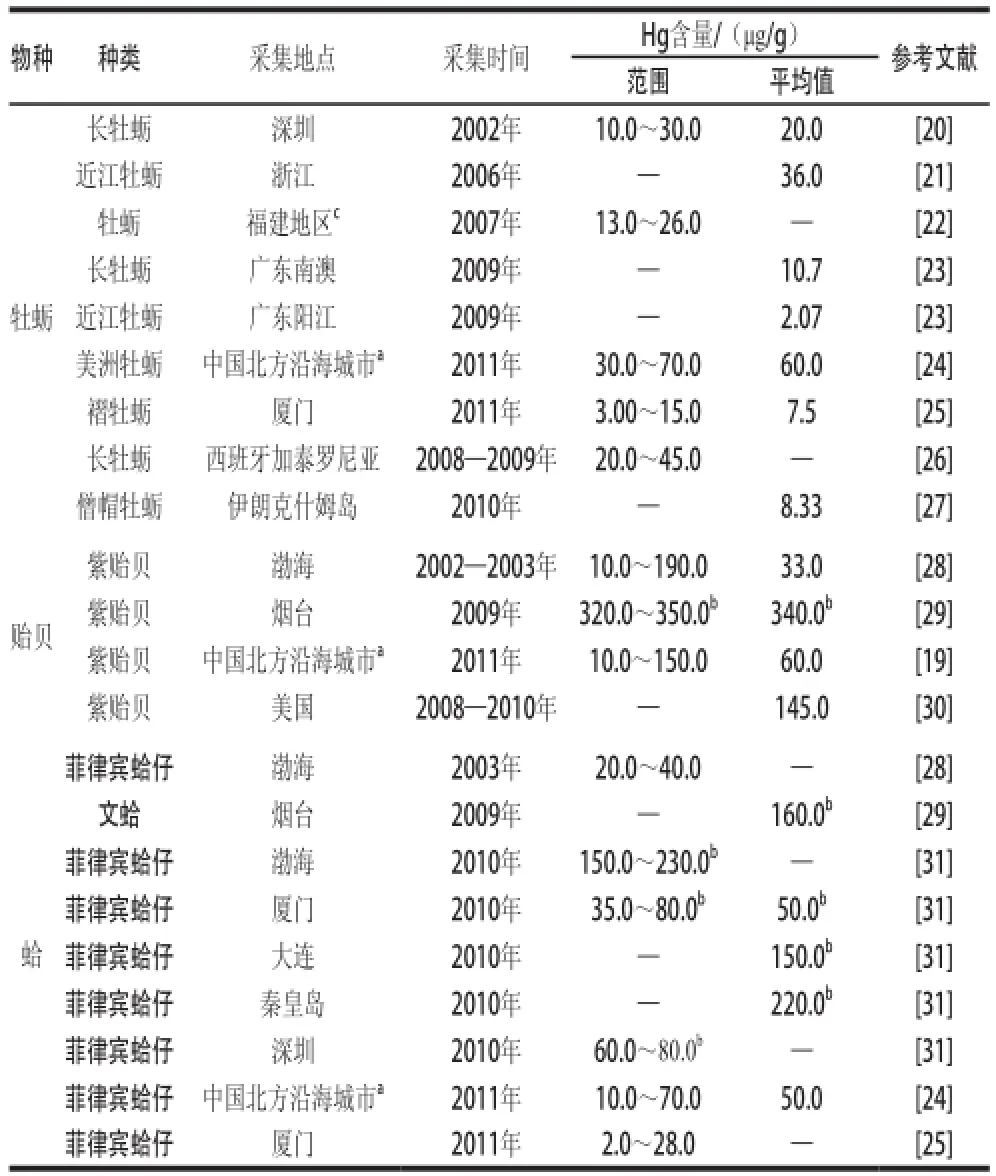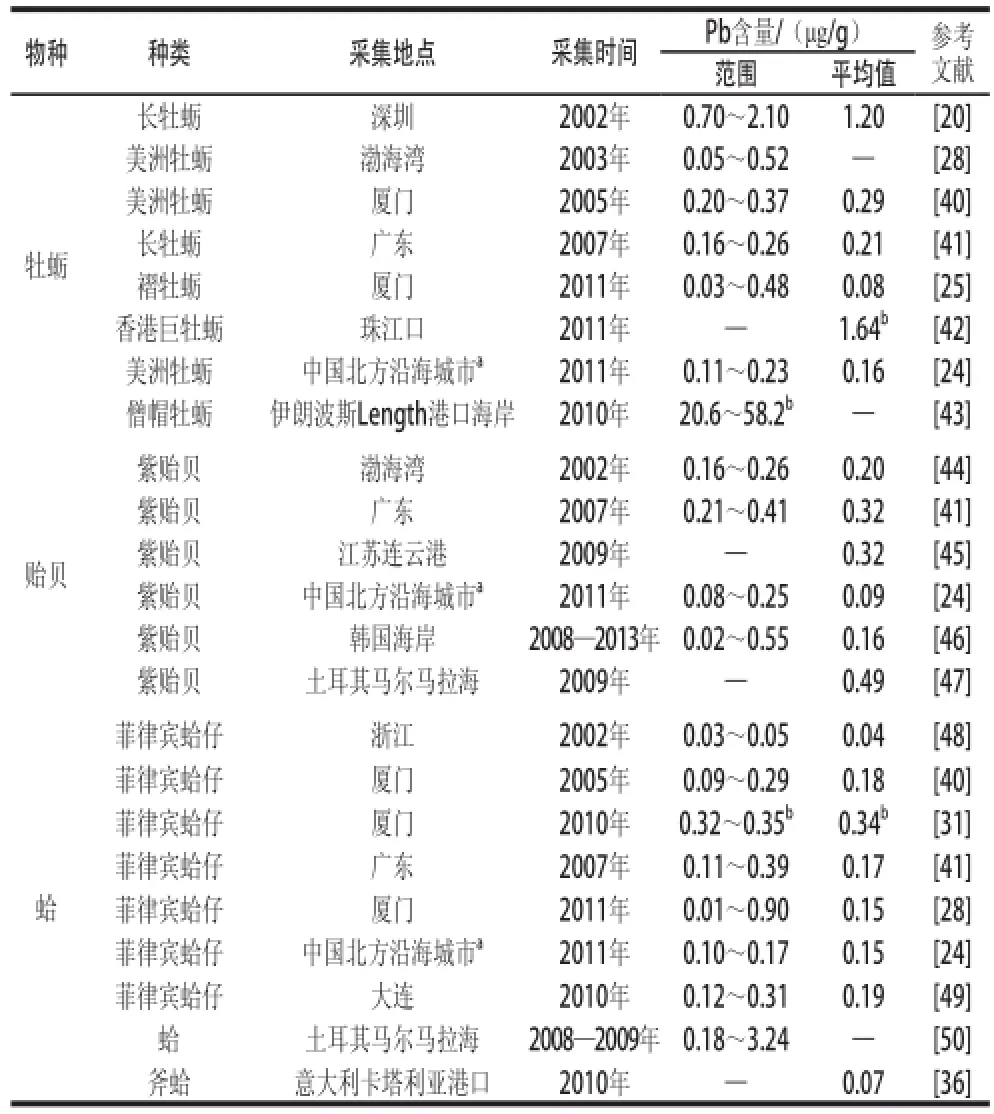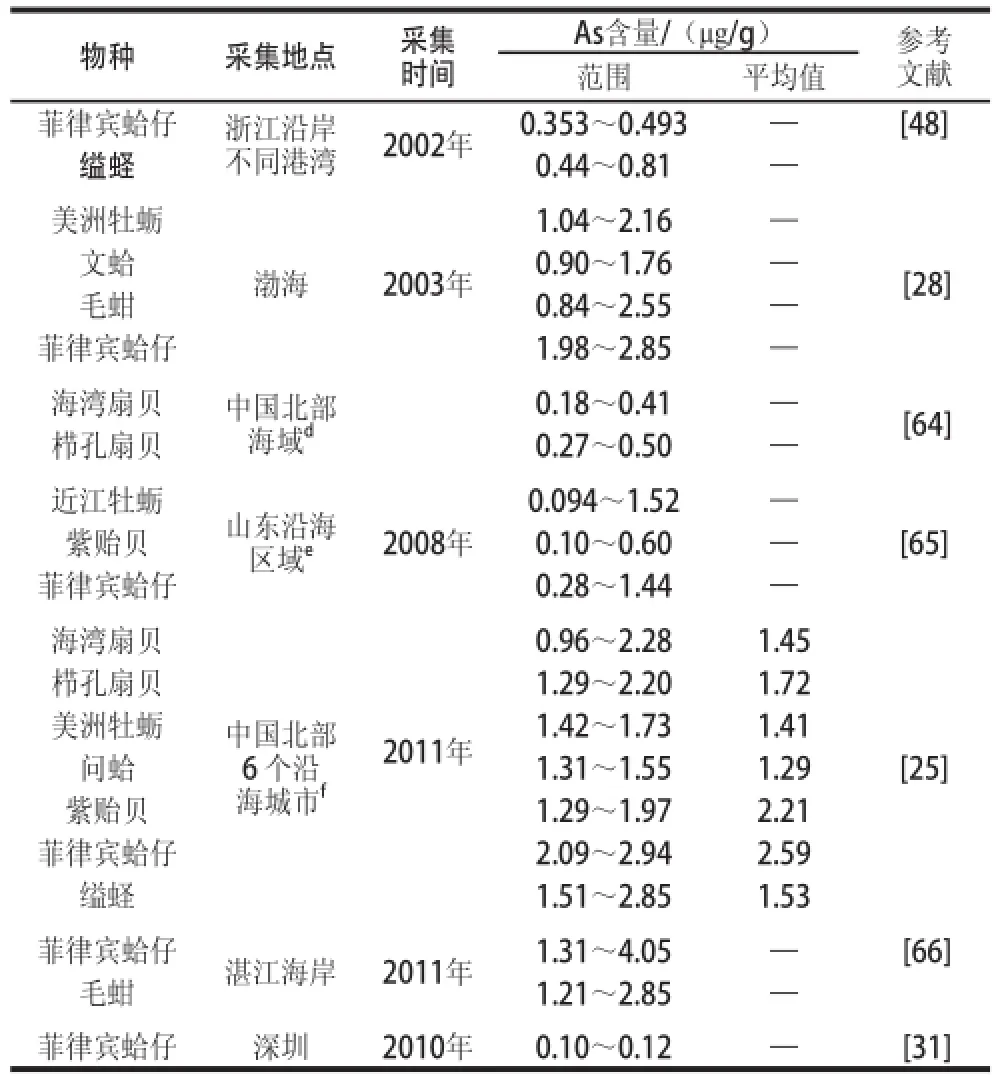近海海域海产品汞、铅和砷污染状况的研究进展
童永彭,朱志鹏
(深圳大学物理科学与技术学院,广东 深圳 518000)
近海海域海产品汞、铅和砷污染状况的研究进展
童永彭,朱志鹏
(深圳大学物理科学与技术学院,广东 深圳518000)
海产品是人们喜爱的食品之一,然而随着工业的迅猛发展,排放到近海海域的有毒元素汞(Hg)、铅(Pb)和砷(As)已经威胁到海产品的食品安全。本文通过对2005—2015年欧洲(意大利、挪威等)、中东地区(土耳其、伊朗等)及中国近海海域海产品中Hg、Pb和As含量对比分析,结果得出:1)中东地区及中国近海海域海产品Hg含量有部分超标。2)中东近海海域海产品Pb含量远高于中国近海海域和欧洲近海海域并大部分超标,其中双壳贝类Pb含量普遍高于鱼类。3)欧洲(意大利、挪威等)近海海域海产品As含量显著高于其他地区并大部分超标。4)中国北方沿海地区的双壳贝体内Hg含量普遍大于东南沿海地区。
海产品;汞;铅;砷
海产品包括鱼类、贝类、虾类等。目前,全世界的海产品年产量维持在1.2 亿t左右。2007年我国海产品年人均消费量为26 kg,欧洲地区居民海产品年人均消费量为24.5 kg。然而随着海洋环境污染越来越严重,海洋中的生物也在不同程度的受到污染。海产品是人类摄入重金属污染物的重要途径之一[1],所以当人们食用这些受到重金属污染的海产品时就可能会对身体产生影响。目前对世界范围内近海海域海产品重金属污染的综述较少,本文对2005—2015年欧洲(意大利、挪威等)、中东地区(土耳其、伊朗等)及中国近海海域海产品中汞、铅和砷含量进行综述。
1 近海海域海产品中Hg含量
Hg是水环境中主要重金属污染物之一。Hg2+能通过土壤、海水和海底沉积物中细菌的作用转换成有机汞等毒性化合物被浮游植物吸取[2],然后沿着食物链积累[3]。Tuzen[4]在2008年对土耳其北部黑海地区不同的海洋鱼类Hg含量调查发现,其最低Hg含量为0.025 μg/g(以湿质量计,下同),而最高Hg含量为0.084 μg/g。Aksu等[5]在2009年对位于土耳其西北方向的马尔马拉海岸地区的鲟鱼Hg含量调查发现,其Hg含量为0.01~0.18 μg/g(以干质量计)。Yabanli[6]在2010年对位于土耳其西部港口城市伊兹密尔海岸的沙丁鱼Hg含量调查发现,其Hg含量平均值为0.03 μg/g。Alkan等[7]在2011年对土耳其东北部港口城市特拉布宗海洋鱼类Hg含量调查发现,牙鳕体内的Hg含量范围为0.01~0.15 μg/g(以干质量计),羊鱼Hg含量范围为0.07~0.18 μg/g(以干质量计),将干质量含量转换为湿质量含量(干质量时的重金属含量=湿质量时的重金属含量×5)[8],可以看出土耳其沿海地区鱼类Hg含量远远小于标准值(0.5 μg/g)[9]。Saei-Dehkordi等[10]在2009年对伊朗南部阿巴斯港两种海洋鱼类(栖息水底鱼类和浮游鱼类)Hg含量调查发现,其Hg含量范围为0.120~0.527 μg/g,而居于水底的鱼类Hg含量要大于浮游鱼类中Hg含量。Raissy等[11]在2012年对伊朗南部沿海城市Hendijan鱼类Hg含量调查发现,其Hg含量范围为0.049~0.402 μg/g。Julshamn等[12]在2010年对在巴伦支海东北部的鳕鱼调查发现,其肌肉中的Hg含量范围为0.01~0.16 μg/g,而肝脏中Hg含量最高值为0.12 μg/g,这比在2006年对挪威北部大比目鱼体内Hg含量的调查结果低的多[13]。然而Julshamn等[14]在2010年对位于北海的挪威沿岸的鳕鱼做了调查发现,其肌肉中Hg含量是巴伦支海东北部的鳕鱼肌肉Hg含量的3 倍,这种差异是由于北海地区有着密集的工厂区从而导致重金属污染物排放较多。而对于意大利沿岸地区,Perugini等[15]在2010年调查了位于意大利亚德里亚海的亚卡布岛两种海底鱼类(羊鱼、欧洲鳕鱼)和两种海洋上层的鱼类(蓝鳕鱼、鲭鱼),其中欧洲鳕鱼Hg含量最高,平均值达到了0.59 μg/g,蓝鳕鱼Hg含量最低,为0.36 μg/g,且居于海底的鱼类Hg含量要高于海洋上层的鱼类中Hg含量。
上述地区的沿海地区鱼类Hg含量(除土耳其和意大利部分鱼类)基本没有超过标准值。中东地区(土耳其、伊朗)的鱼类Hg含量变化较大,这可能是由于地理位置、营养等级、身体大小的区别造成的。通过Saei-Dehkordi[10]和Perugini[15]等报道发现:居于海洋下层的鱼类体内的Hg含量要比海洋上层的鱼类的Hg含量高,其原因可能是由于其食物的来源不同。栖息海底的鱼类以无脊椎动物为食,而无脊椎动物以底泥为食,底泥中的Hg含量较高,这样使得无脊椎动物体内积累更多的Hg,从而使得栖息海底的鱼类Hg含量较高。
中国沿海地区鱼类Hg含量的调查报告也有许多。Xia Chonghuan等[16]在2008年对中国东部9 个城市(大连、天津、青岛、上海、舟山、温州、福州、泉州和厦门)的近海海域鱼类Hg含量调查发现,其含量范围在0.007~0.053 μg/g,其中大黄鱼的Hg含量最高,为0.053 μg/g,这表明东海地区海洋鱼类Hg含量是较低的,未发现超标。Liu Jinling等[17]在2012年对海南岛地区的肉食性鱼类、杂食性鱼类和食草类鱼类调查发现,其Hg含量范围为0.008~0.293 μg/g,其中石鱼Hg含量最高,并且肉食性鱼类Hg含量普遍高于杂食性鱼类和食草性鱼类。Liu Jinling等[18]在2013年对中国南海地区的海南岛的鱼类做调查发现河豚Hg含量最低,为0.036 μg/g,石鱼Hg含量最高,为0.417 μg/g。Pan Ke等[19]在2011年对珠江三角洲地区的18 种海洋鱼类Hg含量调查发现,其体内Hg含量范围为0.004~0.148 μg/g。通过以上近几年对中国沿海地区海产品鱼类Hg含量调查可知中国沿海地区海产品鱼类Hg含量总体较低且没有超过标准值,海南岛地区的鱼类的Hg含量高于其他沿海地区,这可能是由于地域的差异和不同鱼类富集Hg的能力不同而造成的。
表1为近10a近海海域海产品双壳贝类Hg含量的变化。中国北方沿海地区(大连、青岛、潍坊、威海、日照、烟台)双壳贝类海产品Hg含量普遍高于东南沿海区域(福建,浙江等)。与国外几例双壳贝类Hg含量报道处于相当的范围(均<0.20 μg/g),未出现超标(>0.30 μg/g)现象。

表1 不同沿海地区的双壳贝类体内Hg含量的对比Table 1 Comparison with Hg concentrations in bivalves from diffe rent coastal areas
2 近海 海域海产品中Pb含量
重金属Pb也是众所周知的有毒元素。Uluozlu等[32]在2005年对土耳其境内的黑海和爱琴海附近区域鱼类Pb含量调查发现,牙鳕其体内的Pb含量最高,为0.17 μg/g(以湿质量,下同),欧洲鳀鱼Pb含量最低,为0.04 μg/g。Aksu等[5]在2009年对位于土耳其西北方向的马尔马拉海岸地区的鲟鱼Pb含量调查发现,其Pb含量在0.50~2.06 μg/g,远远超过了欧盟食品监管中心对鱼类规定食用标准值。Yabanli[6]在2010年对土耳其西部港口城市伊兹密尔海岸的沙丁鱼Pb含量调查发现,其平均值为0.14 μg/g,Alkan等[7]在2011年对土耳其东北部港口城市特拉布宗鱼类Pb含量调查发现,牙鳕中的Pb含量范围为0.01~0.25 μg/g(以干质量计),羊鱼中的Pb含量范围为0.01~0.20 μg/g(以干质量计)。Yipel等[33]在2012年对位于土耳其南部港口城市安塔利亚的鱼类Pb含量调查发现,羊鱼Pb平均含量为0.29 μg/g(以干质量计),而乌头鱼Pb含量为0.22 μg/g(以干质量计)。将干质量含量转换为湿质量含量[8],发现在土耳其沿海地区的鱼类Pb含量大部分都未超过标准值。Hosseini等[34]对2011年对伊朗波斯湾地区4 种鱼类Pb含量调查发现,其Pb含量范围在0.26~0.31 μg/g,Tabari等[35]在2008年对伊朗里海地区的78 个鱼类样本Pb含量调查发现,其平均含量范围为0.078~0.180 μg/g。而在欧洲地区,Julshamn等[13]在2006年对挪威北部沿海地区大比目鱼Pb含量调查发现,Pb含量最高为0.05 μg/g。同时Julshamn等[14]在2010年又对挪威沿海地区687 条鳕鱼Pb含量调查发现,其Pb含量也非常低,只有52 个肌肉样本和114 个肝脏样本高于0.01 μg/g。这与其在2010年对挪威巴伦支海的东北部的鳕鱼中Pb含量调查结果相符合,其中肌肉样本中最高Pb含量仅为0.06 μg/g,肝脏样本中最高Pb含量为0.11 μg/g[12]。同样,Perugini等[15]2010年对意大利亚德里亚海的亚卡布岛4 种鱼类Pb含量调查发现,羊鱼体内Pb含量平均值最高,为0.05 μg/g。Copat等[36]2012年对意大利港口城市卡塔利亚5 种鱼类Pb含量调查发现,羊舌鲆的Pb含量最高,为0.021 μg/g。通过以上数据表明土耳其沿海地区和欧洲地区(挪威、意大利)的鱼类Pb含量远低于标准值[9]。
而国内的报道中,Zeng Yanyi等[37]2009年对珠江三角洲地区鱼类体内的Pb含量调查发现,其Pb含量平均值达到了0.43 μg/g。Zhang Wei等[38]2010年对中国几个地区(秦皇岛、大连、青岛、上海、湛江、惠来、海口、珠江三角洲)海洋鱼类Pb含量调查发现,秦皇岛地区的乔式龙舌鱼Pb含量最高,为0.29 μg/g,而珠江三角洲地区的鱼类Pb含量普遍高于其他地方,这与姜杰等[39]在2007年对广东沿海海域海产品调查结果相似。通过以上的数据发现珠江三角洲地区鱼类Pb含量较高,其原因可能与珠江三角洲地区的海底沉积物Pb含量很高有关,这说明珠江三角洲地区的重金属Pb污染还是比较严重。
为了进一步比较近10 a近海海域海产品中双壳贝类Pb含量的变化,将其报道的结果列于表2。

表2 不同沿海地区的双壳贝类体内Pb含量的对比Table 2 Comparison with Pb concentrations in bivalves from different areas
由表2可知,中东地区(伊朗、土耳其等)双壳贝类Pb含量要远高于其他国家地区且大部分超过标准值。通过比较伊朗地区的鱼类中Pb含量(0.078~0.31 μg/g)和双壳贝类(20.6~58.2 μg/g,以干质量计)、珠江三角洲地区鱼类(0.43 μg/g)和深圳牡蛎(1.20 μg/g)中Pb含量,发现双壳贝类Pb含量明显高于鱼类Pb含量。通过近年来的工作研究也发现国内近海海域海产品双壳贝类Pb含量明显高于鱼类,这可能是由于一方面与陆地径流排入海洋的重金属大量沉积于底泥中,造成以沉积物为食的甲壳类、贝壳类生物选择吸收重金属并在体内不断富集有关;另一方面,也与贝壳类软体动物的“非选择性”滤食特性,以及具有较高产生金属结合蛋白的能力等有关[51-55]。而鱼类通常生活在海水中,且对重金属的蓄积要通过复杂的食物链来转换,以致含量相对较低[56]。而对于不同种类双壳贝类Pb富集能力,并没有显著差异。通过比较发现不同海域双壳贝类中Pb含量顺序为中东近海海域>中国近海海域>欧洲近海海域。
3 近海海域海产品中As含量
不同形态As毒性不同,一般来说无机As比有机As毒性高。在海洋食物中,90%的As以有机形式存在[57]。一般来说底层海洋动物比浮游的海洋生物的As含量要高[58]。与中国疾病预防控制中心营养与食品安全所对贝类规定食用标准值(1.0 μg/g)相比,目前研究报道海产品中As含量超标的较多。
Aksu等[5]2009年对位于土耳其西北方向马尔马拉沿海的鲟鱼(Merluccius merluccius)As含量调查发现,其含量范围为0.01~0.21 μg/g(以干质量计)。Yabanli[6]2010年对位于土耳其西部港口城市伊兹密尔海岸的沙丁鱼As含量调查发现,其平均值为1.49 μg/g(以湿质量计,下同)。Julshamn等[13]2006年对挪威北部海岸大比目鱼As含量调查发现,其肌肉中As含量范围为2.0~41 μg/g。Sirot等[59]2008年对法国沿海地区的52 种海洋鱼类As含量调查发现,其As含量范围为0.71~34.3 μg/g。Perugini[15]2010年对意大利亚德里亚海亚卡布岛4 种鱼类As含量调查发现,其As含量范围为30.76~59.91 μg/g,Copat等[36]2012年对意大利港口城市卡塔利亚5 种鱼类As含量调查发现,其As含量平均值为3.135~11.024 μg/g,这显示欧洲(意大利,挪威,法国)近海海域海产品鱼类As含量严重超标。Raissy等[11]2012年对伊朗波斯湾地的海洋鱼类As含量调查发现,其As含量为0.168~0.479 μg/g,其他有关伊朗沿海地区海洋鱼类As含量调查报告[10,60-61]也发现伊朗近海海域海产品鱼类As含量较低,且没有超标。孙维萍等[62]2006年对浙江沿海6 种鱼类As含量调查发现,其As含量为0.02~1.32 μg/g,Wu Xing等[63]2011年对山东的东部沿岸线8 座城市的海洋鱼类As含量调查发现,其As含量平均值为0.037 μg/g。由此可见,欧洲(意大利、挪威)近海海域海产品鱼类As含量远高于其他两地区且严重超标。

表3 中国不同沿海地区的双壳贝体内As含量的对比Table 3 Comparison of the bivalves As concentrations in different coastal areas of China in recent years
由表3可知,通过对中国北部海域近几年的双壳贝体内As含量的对比,其As含量随时间有上升的趋势。易斌等[67]2007—2010年对大亚湾海域海产品调查也发现其甲壳类体内As含量随时间呈现上升趋势。
4 结 语
通过对近几年土耳其、意大利、伊朗、挪威、中国等国家的海产品中Hg、Pb和As含量的比较得出:伊朗地区海产品Pb含量最高,且大部分超标,这和其石油及其炼油工业有关;意大利地区的海产品As含量明显高于其他地方,这也许和海域As含量分布有关;中国沿海地区的海产品Pb含量较高并部分超标;中国北方沿海地区的双壳贝类Hg含量普遍高于中国东南沿海地区,这与地区性环境污染有关;北部沿海地区的双壳贝类体内As含量上升趋势明显并部分超标;而对重金属积累能力的比较发现居于海底的鱼类积累Hg的能力大于居于海洋上层的鱼类积累Hg的能力;而双壳贝类富集Pb的能力大于鱼类富集Pb能力。
通过对海产品Hg、Pb和As污染状况的综述,了解到目前海产品中有毒元素污染仍较严重,尤其海产品As含量上升趋势明显。因此对海产品有毒元素污染的控制与监管必须加强,并制定相关政策以增加大众对环境保护意识。
[1]JARUP L. Hazards of heavy metal contamination[J]. British Medical Bulletin, 2003, 68(1): 167-182.
[2]WATRAS C J, BLOOM N S. Mercury and methylmercury in individual zooplankton-implications for bioaccumulation[J]. Limnology and Oceanography, 1993, 37(6): 1313-1318.
[3]PICKHARDT P C, FISHER N S. Accumulation of inorganic and methylmercury by freshwater phytoplankton in two contrasting water bodies[J]. Environmental Science & Technology, 2007, 41(26): 125-131.
[4]TUZEN M. Toxic and essential trace elemental contents in fish species from the Black Sea, Turkey[J]. Food Chemistry, 2009, 47(8): 1785-1790.
[5]AKSU A, BALKIS N, TASKIN O S, et al. Toxic metal (Pb, Cd,As and Hg) and organochlorine residue levels in hake (Merluccius merluccius) from the Marmara Sea, Turkey[J]. Environment Monitoring and Assessment, 2011, 184(1/4): 508-524.
[6]YABANLI M. Assessment of the heavy metal contents of Sardina pilchardus sold in Izmir, Turkey[J]. Ekoloji, 2013, 22(87): 10-25.
[7]ALKAN N, AKTAS M, GEDIK K. Comparison of metal accumulation in fish species from the southeastern Black Sea[J]. Bulletin of Environmental Contamination and Toxicology, 2012, 88(6): 807-812.
[8]WEI Yihua, ZHANG Jinyan, ZHANG Dawen, et al. Metal concentrations in various fish organs of different fish species from Poyang Lake, China[J]. Ecotoxicology and Environmental Safety,2014, 104(1): 182-188.
[9]中国疾病预防控制中心营养与食品安全所, 卫生部卫生监督中心. GB/T 2762—2005 食品中污染物限量[S]. 北京: 中国标准出版社, 2005.
[10] SAEI-DEHKORDI S S, FALLAH A A, NEMATOLLAHI A. Arsenic and mercury in commercially valuable fish species from the Persian Gulf: influence of season and habitat[J]. Food and Chemical Toxicology, 2010, 48(10): 2945-2950.
[11] RAISSY M, ANSARI M. Health risk assessment of mercury and arsenic associated with consumption of fish from the Persian Gulf[J]. Environmental Monitoring and Assessment, 2014, 186(2):1235-1240.
[12] JULSHAMN K, DUINKER A, NILSEN B M, et al. A baseline study of levels of mercury, arsenic, cadmium and lead in Northeast Arctic cod (Gadus morhua) from different parts of the Barents Sea[J]. Ma rine Pollution Bulletin, 2013, 67(1/2): 187-195.
[13] JULSHAMN K, FRANTZEN S, VALDERSNES S, et al. Concentrations of mercury, arsenic, cadmium and lead in Greenland halibut (Reinhardtius hippoglossoidies) caught off the coast of northern Norway[J]. Marine Biology Research, 2011, 7(8): 733-745.
[14] JULSHAMN K, DUINKER A, NILSEN B M, et al. A baseline study of metals in cod (Gadus morhua) from the North Sea and coastal Norwegian waters, with focus on mercury, arsenic, cadmium and lead[J]. Marine Pollution Bulletin, 2013, 72(1): 264-273.
[15] PERUGINI M, VISCIANO P, MANERA M, et al. Heavy metal(As, Cd, Hg, Pb, Cu, Zn, Se) concentrations in muscle and bone of four commercial fish caught in the central Adriatic Sea, Italy[J]. Environmental Monitoring and Assessment, 2014, 186(4): 2205-2213.
[16] XIA Chonghuan, WU Xiaoguo, LAM J C W, et al. Methylmercury and trace elements in the marine fish from coasts of East China[J]. Journal of Environmental Science and Health, 2013, 48(12): 1491-1501.
[17] LIU Jinling, XU Xiangrong, YU Shen, et al. Mercury contamination in fish and human hair from Hainan Island, S outh China Sea: implication for human exposure[J]. Environmental Research, 2014, 135: 42-47.
[18] LIU Jinling, XU Xiangrong, YU Shen, et al. Mercury pollution in fish from South China Sea: levels species-specific accumulation and possible sources[J]. Environmental Research, 2014, 131: 160-164.
[19] PAN Ke, CHAN H D, TAM Y K, et al. Low mercury levels in marine fish from estuarine and coastal environments in southern China[J]. Environmental Pollution, 2014, 185: 250-257.
[20]程华胜, 徐铁肖, 江天久, 等. 深圳近岸养殖牡蛎体内污染物研究[J].生态科学, 2004, 23(1): 20-24.
[21] 孙维萍, 潘建明, 刘小涯, 等. 浙江沿海贝类体内重金属元素含量水平与评价[J]. 海洋学研究, 2010, 28(4): 43-49.
[22] 李磊, 袁琪, 平仙隐, 等. 东南沿岸海域牡蛎体内的重金属含量及其污染评价[J]. 海洋通报, 2010, 29(6): 678-684.
[23] 王增焕, 林钦, 王许诺, 等. 华南沿海牡蛎重 金属含量特征及其风险评估[J]. 水产学报, 2011, 35(2): 291-297.
[24] LI Peimiao, GAO Xuelu. Trace elements in major marketed marine bivalves from six northern coastal cities of China: concentrations and risk assessment for human health[J]. Ecotoxicology and Environmental Safety, 2014, 109: 1-9.
[25] LI Jian, HUANG Zhiyong, HU Yue, et al. Potential risk assessment of heavy metals by consuming shellfish collected from Xiamen,China[J]. Environmental Science and Pollution Research, 2013,20(5): 2937-2947.
[26] OCHOA V, BARATA C, RIVA M C. Heavy metal content in oysters(Crassostrea gigas) cultured in the Ebro Delta in Catalonia, Spain[J]. Environmental Monitoring and Assessment, 2013, 185(8): 6783-6792.
[27] GOLSHAN S, ALIREZA R B, ALI K, et al. Oyster Saccostrea cucullata as a biomonitor for Hg contamination and the risk to humans on the coast of Qeshm Island, Persian Gulf, Iran[J]. Bulletin of Environmental Contamination and Toxicology, 2012, 88(6): 962-966.
[28] WANG Yawei, LIANG Lina, SHI Jianbo, et al. Study on the contamination of heavy metals and their correlations in mollusks collected from coastal sites along the Chinese Bohai Sea[J]. Environmental International, 2005, 31(8): 1103-1113.
[29] 邵丽娜, 任宗明, 张高生, 等. 烟台近海海域经济类海洋生物体内Sn,Hg的含量分析[J]. 环境科学, 2011, 32(3): 1698-1702.
[30] KWON S Y, BLUM J D, CHEN C Y, et al. Mercury isotope study of sources and exposure pathways of methylmercury in estuarine food webs in the northeastern US[J]. Environmental Science & Technology,2014, 48(17): 10089-10097.
[31] YANG Feng, ZHAO Liqiang, WU Yanxi, et al. Bioaccumulation of trace elements in Ruditapes philippinarum from China: public health risk assessment implications[J]. International Journal of Environmental Research and Public Health, 2013, 10(4): 1392-1405.
[32] ULUOZLU O D, TUZEN M, MENDIL D, et al. Trace metal content in nine species of fish from the Black and Aegean Seas, Turkey[J]. Food Chemistry, 2007, 104(2): 835-840.
[33] YIPEL M, YARSNN E. A risk assessment of heavy metal concentrations in fish and an invertebrate from the Gulf of Antalya[J]. Bulletin Environmental Contamination and Toxicology, 2014, 93(5):542-548.
[34] HOSSEINI M, NABAVIS M B, SEYEDEH N, et al. Heavy metals (Cd,Co, Cu, Ni, Pb, Fe, and Hg) content in four fish commonly consumed in Iran: risk assessment for the consumers[J]. Environmental Monitoring and Assessment, 2015, 187(5): 231-237.
[35] TABARI S, SARAVI S S, BANDANY G A, et al. Heavy metals (Zn,Pb, Cd, and Cr) in fish, water and sediments sampled form sampled form Southern Caspian Sea, Iran[J]. Toxicology and Industrial Health,2010, 26(10): 649-656.
[36] COPAT C, ARENA G, FIORE M, et al. Heavy metals concentrations in fish and shellfish from eastern Mediterranean Sea: consumption advisories[J]. Food and Chemical Toxicology, 2013, 53: 33-37.
[37] ZENG Yanyi, HUANG Xiaoping, YE Feng, et al. Statistical analysis of accumulation patterns of heavy metals in biota from the Pearl River Estuary, South China[J]. Aquatic Ecosystem Health & Management,2012, 15(2): 185-191.
[38] ZHANG Wei, WANG Wenxiong. Large-scale spatial and interspecies differences in trace elements and stable isotopes in marine wild fish from Chinese waters[J]. Journal of Hazardous Materials, 2012, 215: 65-74.
[39] 姜杰, 丘红梅, 张慧敏, 等. 广东沿海海域海产品中重金属的含量及评价[J]. 环境与健康杂志, 2009, 26(9): 814-816.
[40] 阮金山. 厦门海域养殖贝类体内重金属的初步研究[J]. 海洋科学,2007, 33(2): 32-37.
[41] 王许诺, 王增焕, 林钦, 等. 广东沿海贝类4种重金属含量分析和评价[J]. 南方水产, 2008, 4(6): 83-87.
[42] YU Xiujuan, PAN Ke, LIU Fengjie, et al. Spatial variation and subcellular binding of metals in oysters from a large estuary in China[J]. Marine Pollution Bulletin, 2013, 70(1/2): 274-280.
[43] HEIDARI B, BAKHTIARI A R, SHIRNESHAN G. Concentrations of Cd, Cu, Pb and Zn in soft tissue of oyster (Saccostrea cucullata)collected from the Lengeh Port coast, Persian Gulf, Iran: a comparison with the permissible limits for public health[J]. Food Chemistry, 2013,143(3): 3014-3019.
[44] LIANG L N, HE B, JIANG G B, et al. Evaluation of mollusks as biomonitors to investigate heavy metal contaminations along the Chinese Bohai Sea[J]. Science of the Total Environment, 2004,324(1/3): 105-113.
[45] 李玉, 冯志华, 李谷祺, 等. 海产品中重金属Hg、Cd、Pb对人体健康的的潜在风险评价[J]. 食品科学, 2010, 31(21): 390-393.
[46] MOK J S, YOO H D, KIM P H, et al. Bioaccumulation of heavy metals in the mussel Mytilus galloprovincialis in the Changseon area,Korea, and assessment of potential risk to human health[J]. Fisheries and Aquatic Science, 2014, 17(3): 313-318.
[47] SUHENDAN M, DIDEM . A. Heavy metals in mussels (Mytilus galloprovincialis) from Marmara Sea, Turkey[J]. Biological Trace Element Research, 2011, 141(1/3): 184-191.
[48] HUANG H, WU J Y, WU J H. Heavy metal monitoring using bivalved shellfish from Zhejiang Coastal Waters, East China Sea[J]. Environmental Monitoring and Assessment, 2007, 129(1/3): 315-320.
[49] ZHAO Liqiang, YANG Feng, WU Yanxi, et al. Heavy metal concentrations in surface sediments and Manila clams (Ruditapes philippinarum) from the Dalian coast, China after the Dalian port oil spill[J]. Biological Trace Element Research, 2012, 149(2): 241-247.
[50] FATMA A C, HASAN B O, NERMIN B, et al. Proximate and elemental composition of Chamelea gallina from the southern coast of the Marmara Sea (Turkey)[J]. Biological Trace Element Research,2011, 143(2): 983-991.
[51] CHEN Jianming, TONG Yongpeng, XU Jiazhang, et al. Environmental lead pollution threatens the children living in the Pearl River Delta region, China[J]. Environmental Science and Pollution Research,19(8): 3268-3275.
[52] TONG Yongpeng, SUN Huibin, LUO Qi, et al. Study of lead level during pregnancy by application of synchrotron radiation micro XRF[J]. Biological Trace Element Research, 142(3): 380-387.
[53]童永彭, 郝昕, 刘国卿, 等. 海产品污染情况以及铅的生物有效性研究进展[J]. 广东微量元素科学, 2013, 20(3): 27-32.
[54] 童永彭, 郝昕, 孙慧斌, 等. 海滨城市婴儿铅来源的抽样研究[J].深圳大学学报: 理工版, 2014, 31(3): 273-278.
[55] 童永彭, 郝昕, 孙慧斌. 市场海产品铅含量分析以及小鼠对铅的吸收研究[J]. 广东微量元素科学, 2014, 21(10): 21-26.
[56] 杨天池, 施家威, 毛国华. 宁波地区滩涂海产品重金属与多氯联苯污染状况及其环境相关性分析[J]. 中国卫生检验杂志, 2013, 23(9):2157-2161.
[57] JULSHAMN K, VALDERSNES S, DUINKER A, et al. Heavy metals and POPs in red king crab from the Barents Sea[J]. Food Chemistry,2014, 167: 409-417.
[58] KUCUKSEZGIN F, GONUL L T, TASEL D. Total and inorganic arsenic levels in some marine organisms from Izmir Bay (Eastern Aegean Sea): a risk assessment[J]. Chemosphere, 2014, 112(1): 311-316.
[59] SIROT V, GUERIN T, VOLATIER J, et al. Dietary exposure and biomarkers of arsenic in consumers of fish and shellfish from France[J]. Science of the Total Environment, 2009, 407(6): 1875-1885.
[60] RAISSY M, RAHIMI E, NADEALI V, et al. Mercury and arsenic in green tiger shrimp from the Persian Gulf[J]. Toxicology and Industrial Health, 2014, 30(3): 206-210.
[61] AGAH H, LEERMAKERS M, ELSKENS M, et al. Accumulation of trace metals in the muscle and liver tissues of five fish species from the Persian Gulf[J]. Environmental Monitoring and Assessment, 2009,157(1/4): 499-514.
[62] 孙维萍, 刘小涯 盼建明, 等. 浙江沿海经济鱼类体内重金属的残留水平[J]. 浙江大学学报: 理学版, 2010, 39(3): 338-344.
[63] WU Xing, GAO Mi, WANG Lei, et al. The arsenic content in marketed seafood and associated health risks for the residents of Shandong, China[J]. Ecotoxicology and Environmental Safety, 2014,102(1): 168-172.
[64] 王红, 许强, 杨红生. 中国北方海域扇贝重金属含量的比较与质量评价[J]. 海洋科学, 2007, 31(9): 11-18.
[65] 杜瑞雪, 范仲学, 魏爱丽, 等. 山东沿岸经济贝类体内重金属含量分析[J]. 山东农业科学, 2009(8): 58-63.
[66] ZHANG Wei, WANG Wenxiong, ZHANG Li. Arsenic speciation and spatial and interspecies differences of metal concentrations in mollusks and crustaceans from a South China estuary[J]. Ecotoxicology, 2013,22(4): 671-682.
[67] 易斌, 周鹏, 周俊杰. 大亚湾海域2007-2010年海洋生物体内Hg、Pb、Cd 和As 含量及生物质量评价[J]. 海洋环境科学, 2014, 33(2):226-231.
A Review on Hg, Pb and As Contamination of Coastal Seafood
TONG Yongpeng, ZHU Zhipeng
(College of Physics Science and Technology, Shenzhen University, Shenzhen518000, China)
Seafood is one of people's favorite foods. With the rapid development of industry, the industrial emission of the toxic elements Hg, Pb and As has been a threat to the safety of seafood. In this paper, Hg, Pb and As contents in seafood from Europe (Italy and Norway), the Middle East (Turkey and Iran) and some coastal areas of China collected during 2005-2015 are compared. The results show that: 1) Hg content in some seafood from the Middle East and China's coastal areas exceeds the maximum allowable limit; 2) Pb content in most seafood from the Middle East is much higher than in that from coastal areas in China and Europe, and bivalves have higher levels of Pb content than fi shes; 3) As content in most seafood from European (Italy and Norway) coastal areas is signifi cantly higher than in that from other coastal areas and exceeded the maximum allowable limit; 4) Hg content in all investigated bivalves from coastal areas in northern China is higher than in those from coastal areas in southeast China.
seafood; Hg; Pb; As
6
A
1002-6630(2015)23-0301-06
10.7506/spkx1002-6630-201523055
2015-01-28
国家自然科学基金面上项目(11375117)
童永彭(1963—),男,教授,博士,主要从事核技术在环境和医学方面的应用研究。E-mail:yongpeng@szu.edu.cn
——以青岛市为例

